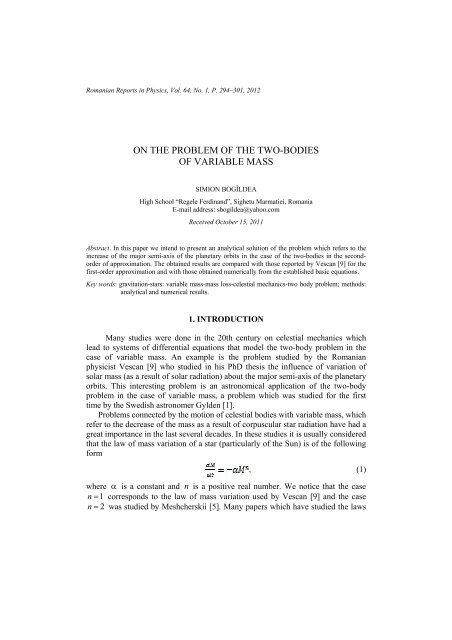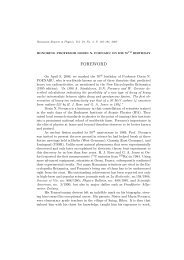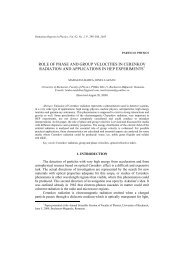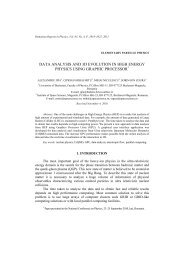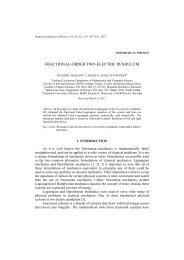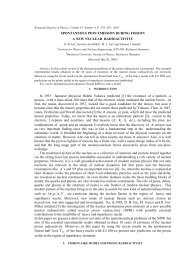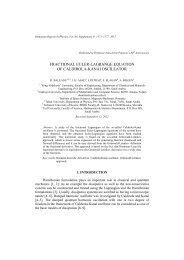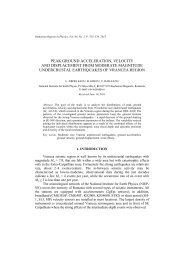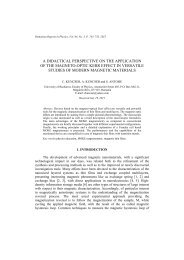on the problem of the two-bodies of variable mass - Romanian ...
on the problem of the two-bodies of variable mass - Romanian ...
on the problem of the two-bodies of variable mass - Romanian ...
Create successful ePaper yourself
Turn your PDF publications into a flip-book with our unique Google optimized e-Paper software.
<strong>Romanian</strong> Reports in Physics, Vol. 64, No. 1, P. 294–301, 2012<br />
ON THE PROBLEM OF THE TWO-BODIES<br />
OF VARIABLE MASS<br />
SIMION BOGÎLDEA<br />
High School “Regele Ferdinand”, Sighetu Marmatiei, Romania<br />
E-mail address: sbogildea@yahoo.com<br />
Received October 15, 2011<br />
Abstract. In this paper we intend to present an analytical soluti<strong>on</strong> <strong>of</strong> <strong>the</strong> <strong>problem</strong> which refers to <strong>the</strong><br />
increase <strong>of</strong> <strong>the</strong> major semi-axis <strong>of</strong> <strong>the</strong> planetary orbits in <strong>the</strong> case <strong>of</strong> <strong>the</strong> <strong>two</strong>-<strong>bodies</strong> in <strong>the</strong> sec<strong>on</strong>dorder<br />
<strong>of</strong> approximati<strong>on</strong>. The obtained results are compared with those reported by Vescan [9] for <strong>the</strong><br />
first-order approximati<strong>on</strong> and with those obtained numerically from <strong>the</strong> established basic equati<strong>on</strong>s.<br />
Key words: gravitati<strong>on</strong>-stars: <strong>variable</strong> <strong>mass</strong>-<strong>mass</strong> loss-celestial mechanics-<strong>two</strong> body <strong>problem</strong>; methods:<br />
analytical and numerical results.<br />
1. INTRODUCTION<br />
Many studies were d<strong>on</strong>e in <strong>the</strong> 20th century <strong>on</strong> celestial mechanics which<br />
lead to systems <strong>of</strong> differential equati<strong>on</strong>s that model <strong>the</strong> <strong>two</strong>-body <strong>problem</strong> in <strong>the</strong><br />
case <strong>of</strong> <strong>variable</strong> <strong>mass</strong>. An example is <strong>the</strong> <strong>problem</strong> studied by <strong>the</strong> <strong>Romanian</strong><br />
physicist Vescan [9] who studied in his PhD <strong>the</strong>sis <strong>the</strong> influence <strong>of</strong> variati<strong>on</strong> <strong>of</strong><br />
solar <strong>mass</strong> (as a result <strong>of</strong> solar radiati<strong>on</strong>) about <strong>the</strong> major semi-axis <strong>of</strong> <strong>the</strong> planetary<br />
orbits. This interesting <strong>problem</strong> is an astr<strong>on</strong>omical applicati<strong>on</strong> <strong>of</strong> <strong>the</strong> <strong>two</strong>-body<br />
<strong>problem</strong> in <strong>the</strong> case <strong>of</strong> <strong>variable</strong> <strong>mass</strong>, a <strong>problem</strong> which was studied for <strong>the</strong> first<br />
time by <strong>the</strong> Swedish astr<strong>on</strong>omer Gylden [1].<br />
Problems c<strong>on</strong>nected by <strong>the</strong> moti<strong>on</strong> <strong>of</strong> celestial <strong>bodies</strong> with <strong>variable</strong> <strong>mass</strong>, which<br />
refer to <strong>the</strong> decrease <strong>of</strong> <strong>the</strong> <strong>mass</strong> as a result <strong>of</strong> corpuscular star radiati<strong>on</strong> have had a<br />
great importance in <strong>the</strong> last several decades. In <strong>the</strong>se studies it is usually c<strong>on</strong>sidered<br />
that <strong>the</strong> law <strong>of</strong> <strong>mass</strong> variati<strong>on</strong> <strong>of</strong> a star (particularly <strong>of</strong> <strong>the</strong> Sun) is <strong>of</strong> <strong>the</strong> following<br />
form<br />
, (1)<br />
where α is a c<strong>on</strong>stant and n is a positive real number. We notice that <strong>the</strong> case<br />
n = 1 corresp<strong>on</strong>ds to <strong>the</strong> law <strong>of</strong> <strong>mass</strong> variati<strong>on</strong> used by Vescan [9] and <strong>the</strong> case<br />
n = 2 was studied by Meshcherskii [5]. Many papers which have studied <strong>the</strong> laws
2 On <strong>the</strong> <strong>problem</strong> <strong>of</strong> <strong>the</strong> <strong>two</strong>-<strong>bodies</strong> <strong>of</strong> <strong>variable</strong> <strong>mass</strong> 295<br />
<strong>of</strong> <strong>mass</strong> variati<strong>on</strong> <strong>of</strong> <strong>the</strong> central body and <strong>the</strong> <strong>problem</strong> <strong>of</strong> <strong>the</strong> <strong>two</strong>-<strong>bodies</strong> with<br />
decreasing <strong>mass</strong> can be found in <strong>the</strong> literature, such as, for example, by Jeans [4],<br />
Hadjidemetriou [2, 3], Schröder and Smith [8]. Some refined analytical soluti<strong>on</strong>s<br />
are given in <strong>the</strong> paper Pal et al. [7].<br />
In this article we will use <strong>the</strong> linear expressi<strong>on</strong> <strong>of</strong> <strong>the</strong> <strong>mass</strong> variati<strong>on</strong> to<br />
establish <strong>the</strong> differential equati<strong>on</strong> <strong>of</strong> <strong>the</strong> trajectory, <strong>the</strong> form <strong>of</strong> planetary orbits and<br />
<strong>the</strong> increase <strong>of</strong> <strong>the</strong> major semi-axis in <strong>the</strong> approximati<strong>on</strong> <strong>of</strong> <strong>the</strong> sec<strong>on</strong>d-order. The<br />
obtained analytical soluti<strong>on</strong> is compared with <strong>the</strong> results reported by Vescan [9]<br />
and with those resulted from <strong>the</strong> integrati<strong>on</strong> <strong>of</strong> equati<strong>on</strong>s using numerical methods.<br />
The obtained results show a very good agreement between <strong>the</strong>m.<br />
2. THE BASIC EQUATIONS<br />
By analogy with <strong>the</strong> radioactivity, Vescan [9] has c<strong>on</strong>sidered <strong>the</strong> law <strong>of</strong><br />
variati<strong>on</strong> <strong>of</strong> <strong>mass</strong> solar <strong>of</strong> <strong>the</strong> form<br />
, (2)<br />
where q is a very small c<strong>on</strong>stant, t is <strong>the</strong> time and µ<br />
0<br />
is <strong>the</strong> <strong>mass</strong> <strong>of</strong> <strong>the</strong> Sun at <strong>the</strong><br />
initial time (initial moment) t<br />
0<br />
. By development in series and limiting to <strong>the</strong> first<br />
<strong>two</strong> terms, it results in <strong>the</strong> following linear expressi<strong>on</strong><br />
. (3)<br />
Then, <strong>the</strong> Newt<strong>on</strong>’s law <strong>of</strong> attracti<strong>on</strong> between <strong>the</strong> Sun and <strong>the</strong> planet <strong>of</strong> <strong>mass</strong> m<br />
can be written as<br />
. (4)<br />
In order to obtain <strong>the</strong> equati<strong>on</strong> <strong>of</strong> <strong>the</strong> planetary orbit, Vescan [9] has used Picard’s<br />
successive approximati<strong>on</strong> method and obtained <strong>the</strong> following equati<strong>on</strong> <strong>of</strong> <strong>the</strong><br />
trajectory<br />
. (5)<br />
This equati<strong>on</strong> shows that <strong>the</strong> trajectory <strong>of</strong> <strong>on</strong>e planet has <strong>the</strong> form <strong>of</strong> an elliptical<br />
spiral or an increasing rosette. The increase <strong>of</strong> <strong>the</strong> major semi-axis during <strong>the</strong><br />
revoluti<strong>on</strong> ∆ a obtained by Vescan [9] is<br />
V<br />
. (6)
296<br />
Simi<strong>on</strong> Bogîldea 3<br />
3. DIFFERENTIAL EQUATION OF THE TRAJECTORY<br />
Because <strong>the</strong> attracti<strong>on</strong> force is a central <strong>on</strong>e, we have<br />
, (7)<br />
where C is <strong>the</strong> c<strong>on</strong>stant area which has <strong>the</strong> expressi<strong>on</strong><br />
, (8)<br />
Then, <strong>the</strong> Newt<strong>on</strong>’s law (4) becomes<br />
], (9)<br />
where<br />
(10)<br />
is an even functi<strong>on</strong>. The expressi<strong>on</strong> <strong>of</strong><br />
trig<strong>on</strong>ometrically series is given by<br />
r<br />
2 ( θ ) developed in a Fourier<br />
].<br />
For <strong>the</strong> approximati<strong>on</strong> <strong>of</strong> <strong>the</strong> sec<strong>on</strong>d order ( n = 2 ), we have<br />
(11)<br />
,<br />
,<br />
. (12)<br />
On <strong>the</strong> o<strong>the</strong>r hand, from (9) we get<br />
. (13)<br />
Using Binet’s formula<br />
(14)<br />
toge<strong>the</strong>r with <strong>the</strong> equati<strong>on</strong>s (9) and (13) it obtains
4 On <strong>the</strong> <strong>problem</strong> <strong>of</strong> <strong>the</strong> <strong>two</strong>-<strong>bodies</strong> <strong>of</strong> <strong>variable</strong> <strong>mass</strong> 297<br />
and it represents <strong>the</strong> differential equati<strong>on</strong> <strong>of</strong> trajectory.<br />
, (15)<br />
4. THE FORM OF THE PLANETARY ORBITS<br />
AND THE EXTENSION OF THE MAJOR SEMI-AXIS<br />
In order to solve equati<strong>on</strong> (15) we look for a soluti<strong>on</strong> <strong>of</strong> <strong>the</strong> form<br />
where ψθ ( ) is a correcti<strong>on</strong> factor. Using (15) and (16) it is found that <strong>the</strong> functi<strong>on</strong><br />
ψθ ( ) must satisfy <strong>the</strong> ordinary differential equati<strong>on</strong><br />
(16)<br />
,<br />
(17)<br />
where <strong>the</strong> prime denotes differentiati<strong>on</strong> with respect to θ. Fur<strong>the</strong>r, using <strong>the</strong> form<br />
<strong>of</strong> equati<strong>on</strong> (17), we assume that its soluti<strong>on</strong> is given by<br />
, (18)<br />
where M, and are unknown functi<strong>on</strong>s <strong>of</strong> having very small numerical<br />
values for . Substituting (18) into (17), we get, by <strong>the</strong> identificati<strong>on</strong> <strong>of</strong><br />
and <strong>the</strong> following algebraic system<br />
M + β = 1,<br />
, β + 2γθ = 0,<br />
The soluti<strong>on</strong> <strong>of</strong> this system is<br />
M = 1 β.<br />
. (19)
298<br />
Simi<strong>on</strong> Bogîldea 5<br />
. (20)<br />
Thus (18) becomes<br />
. (21)<br />
From (16) and (21) we get <strong>the</strong> form <strong>of</strong> <strong>the</strong> planetary orbits:<br />
. (22)<br />
From <strong>the</strong> expressi<strong>on</strong> (22) it can be seen that <strong>on</strong>e more term appears besides <strong>the</strong><br />
result obtained by Vescan [9] in his equati<strong>on</strong> (5). Thus, <strong>the</strong> extensi<strong>on</strong> <strong>of</strong> <strong>the</strong> major<br />
semi-axis during a revoluti<strong>on</strong> is given by<br />
. (23)<br />
5. NUMERICAL RESULTS<br />
On <strong>the</strong> o<strong>the</strong>r side, we determine numerically <strong>the</strong> quantity<br />
, (24)<br />
using <strong>the</strong> following system (see Muchametkalieva and Omarov [6]; Hadjidemetriou,<br />
J. [2, 3])<br />
;<br />
;<br />
;
6 On <strong>the</strong> <strong>problem</strong> <strong>of</strong> <strong>the</strong> <strong>two</strong>-<strong>bodies</strong> <strong>of</strong> <strong>variable</strong> <strong>mass</strong> 299<br />
, (25)<br />
where a, e, ω,<br />
θ and µ represent <strong>the</strong> major semi-axis, <strong>the</strong> eccentricity, <strong>the</strong><br />
argument <strong>of</strong> <strong>the</strong> periheli<strong>on</strong>, <strong>the</strong> true anomaly and <strong>the</strong> <strong>mass</strong> <strong>of</strong> <strong>the</strong> Sun.<br />
The system (25) was integrated numerically for a revoluti<strong>on</strong> using a Fehlberg<br />
fourth-fifth order Runge-Kutta method (MAPLE, rkf45) for <strong>the</strong> values <strong>of</strong> <strong>the</strong><br />
quantities q,<br />
K and µ<br />
0<br />
c<strong>on</strong>sidered by Vescan [9]<br />
. (26)<br />
The initial values (at <strong>the</strong> time t = 0 ) <strong>of</strong> <strong>the</strong> parameters a, e,<br />
ω and θ are given in<br />
Table 1.<br />
6. CONCLUSIONS<br />
The aim <strong>of</strong> this paper is to determine analytically <strong>the</strong> expressi<strong>on</strong>s <strong>of</strong> ∆ a1<br />
given by (23) and numerically <strong>the</strong> expressi<strong>on</strong> <strong>of</strong> ∆ a . The results are presented in<br />
Table 2 where <strong>the</strong>re are included also <strong>the</strong> analytical results obtained by Vescan [9]<br />
given by Eqs. (6). Comparing <strong>the</strong> results given in this table, obtained using <strong>the</strong><br />
analytical and numerical soluti<strong>on</strong>s it can be c<strong>on</strong>cluded that <strong>the</strong>re is a good<br />
agreement between <strong>the</strong>m. Therefore, we are c<strong>on</strong>fident that <strong>the</strong> system (25) can be<br />
used also for <strong>the</strong> present <strong>problem</strong>. On <strong>the</strong> o<strong>the</strong>r hand, from <strong>the</strong> numerical<br />
integrati<strong>on</strong> <strong>of</strong> <strong>the</strong> system (25) it has been found that <strong>the</strong> variati<strong>on</strong> <strong>of</strong> <strong>the</strong> eccentricity<br />
is oscillating <strong>on</strong> time. But, <strong>the</strong> amplitude <strong>of</strong> <strong>the</strong> oscillati<strong>on</strong> is very small (taking as<br />
<strong>on</strong> example <strong>the</strong> Earth <strong>the</strong> difference between <strong>the</strong> maximum and minimum for ten<br />
14<br />
years is <strong>of</strong> order 10 − 11<br />
and for <strong>on</strong>e thousand years it is 10 − ), that means that <strong>the</strong><br />
variati<strong>on</strong> <strong>of</strong> <strong>the</strong> eccentricity is very small. It means that <strong>the</strong> eccentricity is c<strong>on</strong>stant.<br />
This results is in very good agreement with <strong>the</strong> that obtained by Jeans [4].<br />
Table 1<br />
Values <strong>of</strong> a0, e0,<br />
ω0<br />
and θ 0 at <strong>the</strong> initial time, t = 0<br />
Planet<br />
(cm) (rad/s) (rad)<br />
Mercury 5.8·10 12 0.205631752 0<br />
Venus 1.08·10 13 0.006771882 0
300<br />
Simi<strong>on</strong> Bogîldea 7<br />
Table 1 (c<strong>on</strong>tinued)<br />
Earth 1.5·10 13 0.016708617 0<br />
Mars 2.3·10 13 0.09340062 0<br />
Jupiter 7.8·10 13 0.048494851 0<br />
Saturn 1.4·10 14 0.055508622 0<br />
Uranus 2.9·10 14 0.046295899 0<br />
Neptune 4.5·10 14 0.008988095 0<br />
Pluto 6.0·10 14 0.248 0<br />
Table 2<br />
Planet<br />
∆ av<br />
Eq. (6) (cm)<br />
∆ a 1<br />
Eq. (23) (cm)<br />
∆ a<br />
Present numerical results (cm)<br />
Mercury 0.2206957839 0.2324573618 0.22168<br />
Venus 1.044199404 1.045353061 1.0488<br />
Earth 2.373844135 2.384145714 2.3690<br />
Mars 6.911043753 7.077387973 6.8046<br />
Jupiter 146.3728602 148.2003297 145.9688<br />
Saturn 631.7483878 640.7767262 652.952<br />
Uranus 3901.387136 3947.887234 3838.938<br />
Neptune 11701.87184 11729.51855 11701.188<br />
Pluto 24021.61369 25570.68070 23075.000<br />
Acknowledgements. The author wish to express his gratitude to pr<strong>of</strong>essor Ioan M. Pop and<br />
dr. Tiberiu Oproiu for useful comments and references.<br />
REFERENCES<br />
1. Gylden H., Astr<strong>on</strong>. Nachr., Bd.109, 1884 pp.1–6.<br />
2. Hadjidemetriou, J., Two-body <strong>problem</strong> with <strong>variable</strong> <strong>mass</strong>: a new approach, Icarus, 2, 404 (1963).
8 On <strong>the</strong> <strong>problem</strong> <strong>of</strong> <strong>the</strong> <strong>two</strong>-<strong>bodies</strong> <strong>of</strong> <strong>variable</strong> <strong>mass</strong> 301<br />
3. Hadjidemetriou, J., Analytic soluti<strong>on</strong>s <strong>of</strong> <strong>the</strong> <strong>two</strong>-body <strong>problem</strong> with <strong>variable</strong> <strong>mass</strong>, Icarus, 5, 34–46<br />
(1966).<br />
4. Jeans, J.H., Astr<strong>on</strong>omy and Cosmog<strong>on</strong>y, Dover Publicati<strong>on</strong>s, New York, 1961, pp. 298–301<br />
(Reprinted from Cambridge University Press, 2nd Editi<strong>on</strong>, 1929).<br />
5. Meshcherskii, F., Mechanics <strong>of</strong> <strong>variable</strong> <strong>mass</strong> (in Russian), Moskow, 1952.<br />
6. Muchametkalieva, R.K. and Omarov, T.B., Proceedings <strong>of</strong> Astrophysics Institute (in Russian),<br />
Moskow, Vol. XXVIII, 1976.<br />
7. Pal, A.,Şelaru, D.,Mioc, V.,Cucu-Dumitrescu, C., The Gyldén-type <strong>problem</strong> revisited: more refined<br />
analytical soluti<strong>on</strong>s, Astr<strong>on</strong>.Nachr., 327, 304–312 (2006).<br />
8. Schröder, K.P. and Robert C<strong>on</strong>n<strong>on</strong> Smith, Distant future <strong>of</strong> <strong>the</strong> Sun and Earth revisited, M<strong>on</strong>. Not.<br />
R. Astr<strong>on</strong>. Soc. 000, 1–10 (2008).<br />
9. Vescan, T., C<strong>on</strong>tribuţiuni la teoria cinetică şi relativistă a fluidelor reale, PhD <strong>the</strong>sis,Cluj, 1939.<br />
10. Anuarul Astr<strong>on</strong>omic 1999, Editura Academiei Române, Bucharest, 1999.


